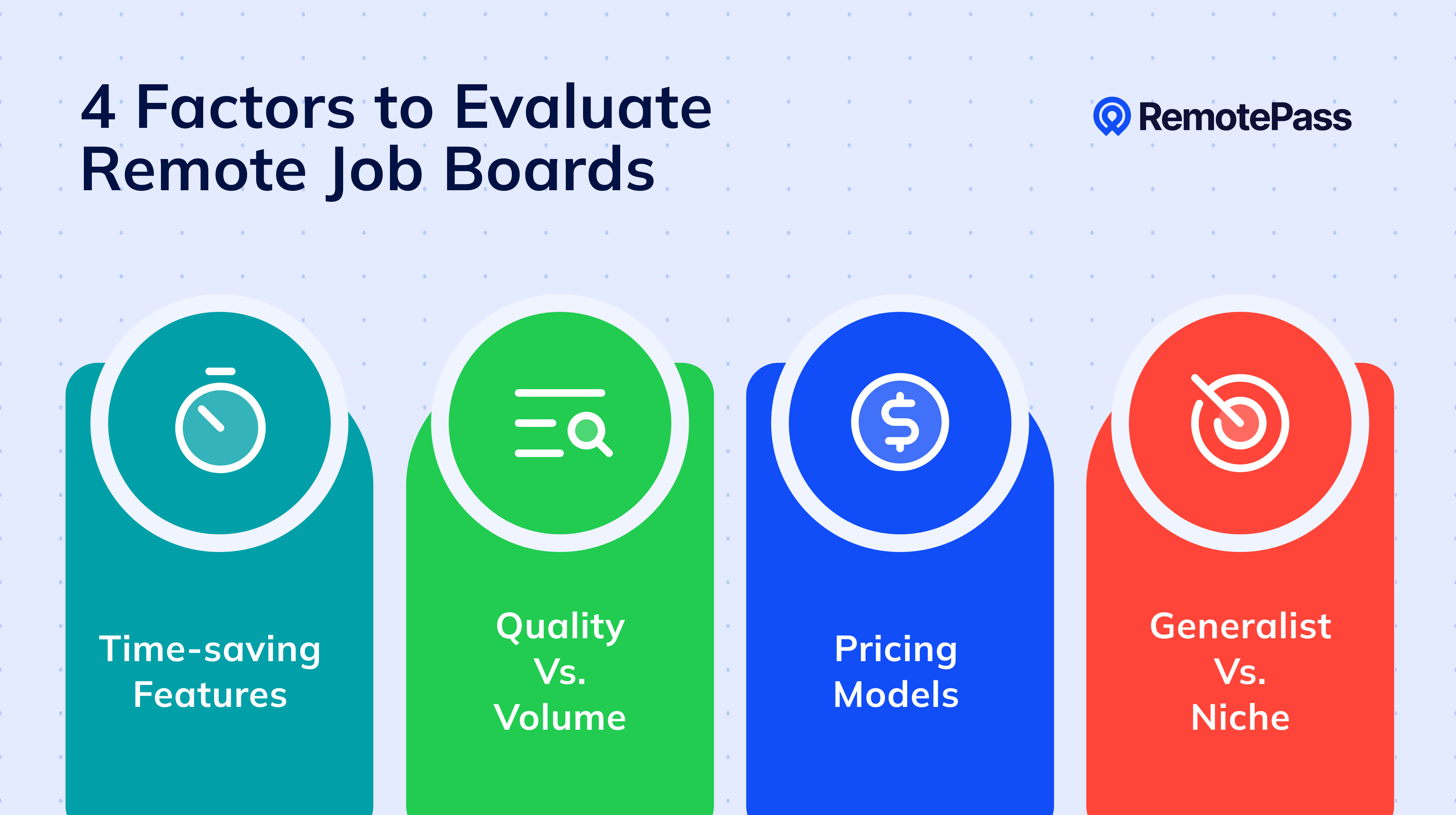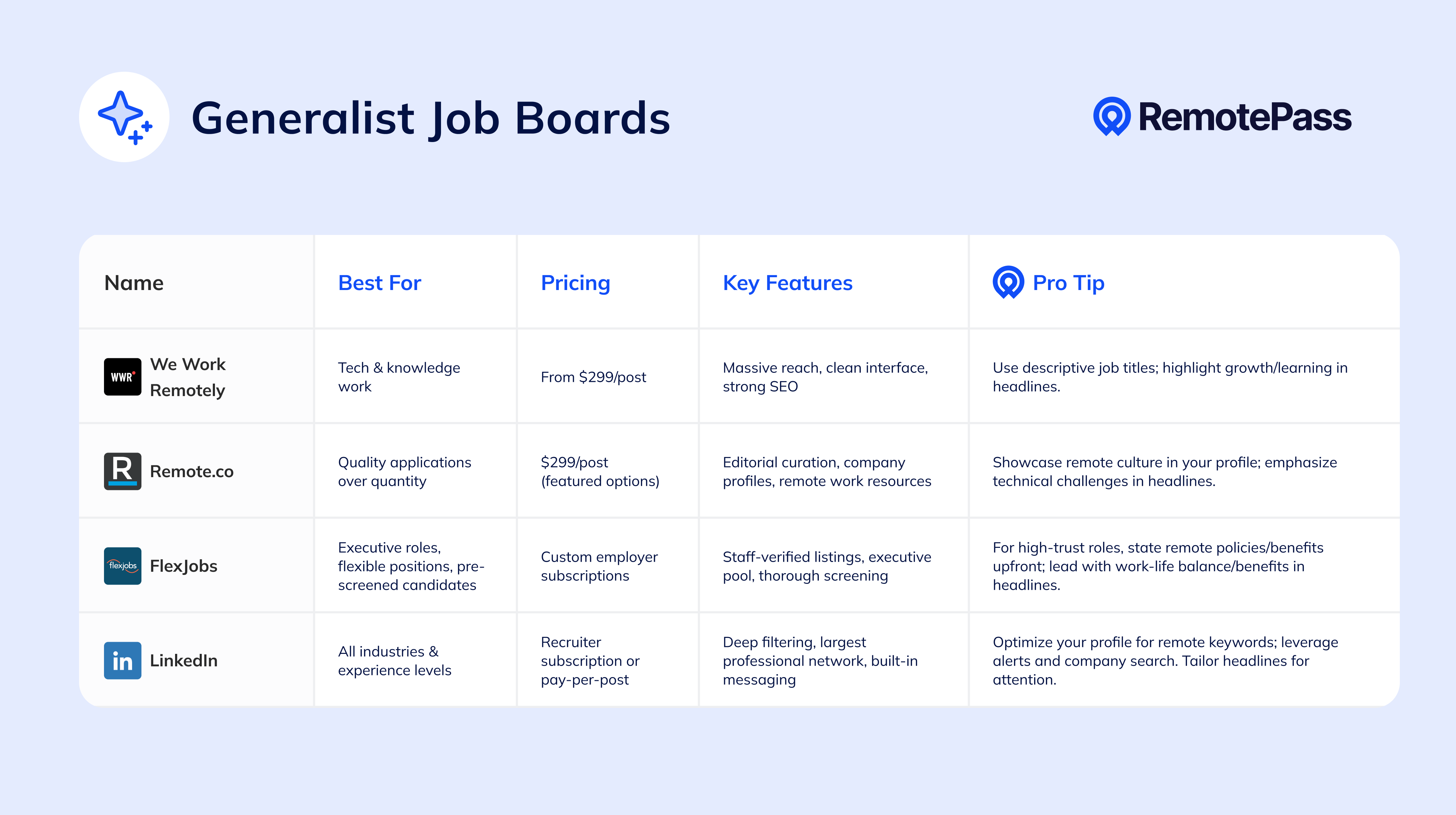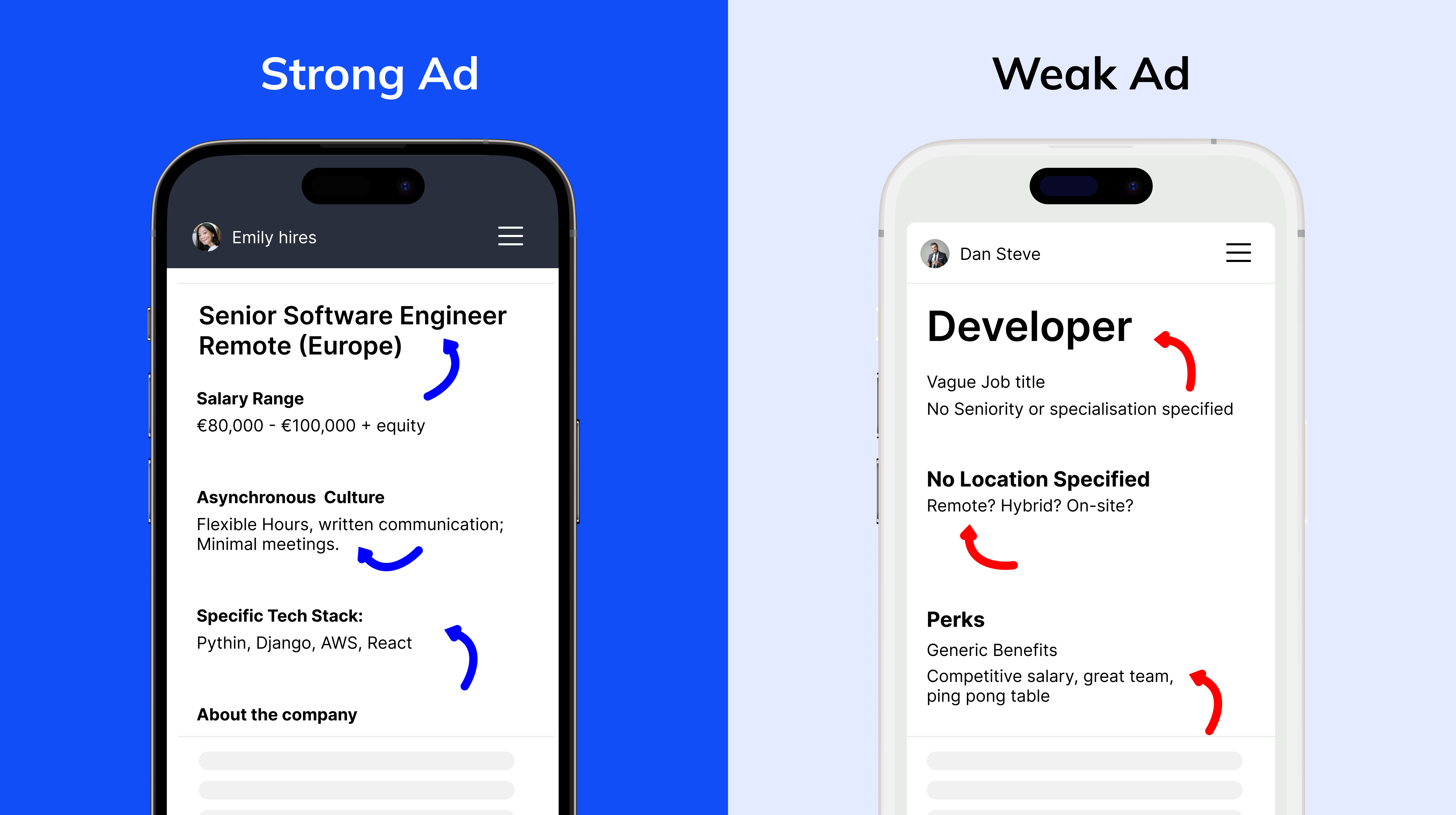The remote work revolution isn't slowing down. According to a 2024 global survey by Slack’s Future Forum, over 72% of employees prefer hybrid work over being fully in-office. Meanwhile, a 2024 Gallup report found that nearly six in ten employees would consider changing jobs if remote flexibility disappeared.
For HR leaders, talent acquisition managers, and startup founders, this means one thing: your hiring strategy needs to be as flexible as the workforce you're trying to attract.
But here's the challenge – with hundreds of job boards claiming to connect you with top remote talent, how do you cut through the clutter and actually reach the right people?
That’s where this guide comes in.
We’ve sorted the best remote job boards into three strategic categories: Generalist, Niche, and Regional platforms. You’ll get the facts, the trade-offs, and the pro tips plus a free Remote Hiring Toolkit to help you measure what’s working.
What Should You Look for in a Remote Job Board?
Smart hiring managers evaluate job boards based on four critical factors:
Audience Quality vs. Volume: A high volume of listings doesn’t mean you’ll find quality candidates. Look for boards that actively vet applicants and foster an engaged, relevant community. If it feels like a free-for-all, it probably is
Pricing Models That Make Sense: Job boards typically offer subscription-based pricing or pay-per-post models. Subscription models work well for companies with consistent hiring needs, while pay-per-post options suit businesses with sporadic recruitment. Calculate your real cost-per-hire, and match the model to your actual hiring pace.
Features That Save Your Time At a minimum, expect built-in screening tools, ATS integrations, and options to show off your remote culture. Bonus points for video interview features and dashboards that tell you who’s biting (and who’s ghosting).
The Niche vs. Volume Trade-off: Generalist platforms give you broad reach but higher competition. Niche boards offer more targeted audiences but smaller candidate pools. The most effective hiring strategies combine both approaches, using generalist boards for broad awareness and niche platforms for specialized roles.

What are the Top Generalist Remote Job Boards?
We Work Remotely
If you want maximum reach without drowning in irrelevant applications, start here. We Work Remotely holds the crown for overall reach and candidate quality in the generalist category, offering a vast array of remote opportunities across various industries, including technology, marketing, design, and customer support
Best for: SaaS companies, tech startups, and businesses looking for marketing and customer success roles
Pricing: Pay-per-post model starting at $299 per job
Key Features: Massive audience reach, clean interface, and strong SEO presence
Pro tip: Write a job title that actually describes the job. You’ll attract serious applicants who actually read past the first line.
Remote.co
Remote.co specializes in curated developer & ops talent with a higher signal-to-noise ratio than many competitors. This platform specializes in handpicked developer and ops talent, cutting down on junk applications. Thanks to their editorial curation, you’ll get fewer but far better candidates.
Best for: Companies prioritizing application quality over quantity
Pricing: $299 per job post with featured listing options
Key Features: Editorial curation, company profiles, and remote work resources
Pro tip: Use your company profile to showcase remote culture. It’s your one chance to show you actually walk the talk.
FlexJobs
FlexJobs is where the serious (and pre-screened) remote job seekers hang out. Every posting gets vetted by actual humans before going live, so you won’t waste time on scammy applicants or “opportunities.” The subscription-based model attracts serious job seekers willing to pay for quality opportunities.
Best for: Executive roles, flexible positions, and companies wanting pre-screened candidates
Pricing: Employer subscriptions, custom-priced based on your needs
Key Features: Staff-verified listings, a pool of executive-level and experienced candidates, and extra-thorough screening
Pro tip: If you’re hiring for high-trust roles, mention your remote policies and benefits upfront. Quality candidates read the fine print.
Don't overlook LinkedIn's built-in remote work filters when posting jobs or sourcing candidates. LinkedIn's platform allows you to specifically target professionals who have indicated they're open to remote work, giving you access to the world's largest professional network of remote-ready talent. The platform's advanced search capabilities let you filter by location preferences, including "remote," "hybrid," or specific geographic regions.
Best for: Professional roles across all industries and experience levels
Pricing: LinkedIn Recruiter subscription or pay-per-post
Key Features:Deep filtering, the biggest professional network on the planet, and built-in messaging for easy outreach
Action Step:
Tailor your headlines for each platform to grab attention:
- We Work Remotely: Spotlight growth and learning opportunities.
- Remote.co: Play up technical challenges and ambitious projects.
- FlexJobs: Lead with work-life balance and standout benefits.
Write like you mean it. Your best candidates will notice.

Best Niche Boards by Function
Developers: Wellfound & Stack Overflow Jobs
When it comes to hiring developers, don't waste your time fishing outside their usual hangouts. Wellfound attracts startup-minded developers seeking equity and growth, while Stack Overflow Jobs reaches the 21 million developers already solving problems on the platform daily.
Why they work: Wellfound developers are motivated by ownership and impact, while Stack Overflow users are already demonstrating their technical problem-solving skills publicly
Best practices: For Wellfound, emphasize equity packages and technical challenges; for Stack Overflow, detail your tech stack and reference specific technologies discussed in their community
Pro tip: Skip the "rockstar developer" clichés. On Wellfound, highlight the problems your startup is solving; on Stack Overflow, mention actual technical challenges your team faces daily
Designers: Dribbble & Behance
Dribbble and Behance are the industry’s go-to platforms for creative professionals to show off their portfolios and for sharp recruiters to find them.
Why they work: Designers use these sites to display real projects, not just list buzzwords. You get to judge talent by actual work, not wishful resumes.
Best Practice: Always review portfolios before reaching out. When you contact a candidate, mention a specific project or style that caught your eye nothing flatters (or opens doors) quite like genuine attention to their craft.
Pro tip: Don’t send generic “We’re hiring” messages. Personalize your pitch. Designers can spot copy-paste a mile off.
Marketing & Sales: MarketerHire & SalesJob
For marketing talent, MarketerHire connects you with pre-vetted freelancers and full-time marketers who've already proven their ROI, while SalesJobs attracts quota-crushing sales professionals actively seeking their next commission opportunity.
Why they work: MarketerHire marketers come with portfolio proof and client testimonials, eliminating the guesswork of hiring decisions, while SalesJobs candidates are revenue-focused professionals who understand the direct connection between performance and paychecks
Best practices: On MarketerHire, specify your marketing challenges and required experience level rather than just listing duties; on SalesJobs, lead with compensation structure, territory details, and realistic quota expectations
Pro tip: Ditch the "marketing ninja" nonsense. On MarketerHire, describe actual campaigns you need executed and metrics that matter; on SalesJobs, be transparent about your sales cycle length and average deal size – top performers want the real numbers upfront.
Customer Support & Operations: Support Driven & Virtual Vocations
Support Driven is where top support professionals swap insights, find jobs, and build careers. Virtual Vocations casts a wider net, serving everyone from full-timers and career switchers to parents, students, retirees, and military spouses, making it a goldmine for operational roles that require reliability and empathy.
Why they work: These platforms attract candidates looking for flexible, remote-first support and ops roles, people who care about both customer experience and work-life balance.
Best practices: Don’t go generic. When writing your job ad, speak the language of your audience: use industry terms, name real challenges, and highlight current team members with similar backgrounds. It makes your role feel real and accessible.
Pro tip: Emphasize flexibility and empathy requirements - these candidates value both professional growth and personal accommodation
Regional & Emerging Platforms
Europe: EU Remote Jobs & Remote in Europe
EU Remote Jobs is the largest remote jobs board dedicated to European time zones with manually curated opportunities. This platform excels at matching North American companies with European talent who can overlap during morning EST hours.
Best for: SaaS companies needing customer success or sales coverage during European business hours
Job ad strategy: Emphasize timezone overlap benefits and specify exact hours (e.g., "9 AM - 1 PM EST overlap required")
Remote in Europe curates remote jobs across programming, design, product, customer success, DevOps, marketing, and management roles.
Best for: Tech startups and mid-market companies hiring developers, designers, and product managers
Job ad strategy: Lead with specific European benefits (generous PTO policies, work-life balance) and mention GDPR-compliant data handling
Latin America: Get on Board & Torre
Get on Board focuses specifically on LATAM tech talent with built-in Spanish/Portuguese language support. Companies using this platform report average salary savings of 30-40% compared to US hires while maintaining quality.
Best for: Startups and scale-ups hiring developers, designers, and digital marketers
Job ad strategy: Post in both English and Spanish, emphasize career growth opportunities and USD compensation
Torre This is an AI-powered matching platform strongest in Colombia, Mexico, and Argentina. Companies see 60% better candidate-job fit scores compared to traditional job boards.
Best for: Companies prioritizing cultural fit and soft skills alongside technical abilities
Job ad strategy: Lead with specific skills over job titles (Torre's AI matches on granular competencies), emphasize growth opportunities, and describe day-to-day impact rather than generic responsibilities.
MENA: Bayt.com & GulfTalent
Bayt.com Over 760 remote job opportunities across Middle East and Gulf regions. This platform dominates the region with 65% market share and strong presence in UAE, Saudi Arabia, and Egypt.
Best for: Customer support, digital marketing, and business development roles
Job ad strategy: Mention flexible Ramadan schedules and Islamic holiday considerations to show cultural awareness
GulfTalent Search for latest jobs in Dubai and Middle East with top employers. Premium positioning attracts senior-level professionals, with average candidate experience of 8+ years.
Best for: Management, finance, and senior technical roles
Job ad strategy: Highlight career progression opportunities and exposure to emerging markets
Action Step:
When entering regional markets, partner with local HR consultants for the first 90 days to optimize job descriptions for cultural nuances and salary benchmarking
How to Craft Effective Remote Job Ads
Be Specific About Location:
State clearly if you’re hiring globally, within certain regions, or in specific time zones. “Anywhere” is not a policy—it’s a recipe for mismatched applicants and wasted time.
Show Your (Async) Culture:
Tell candidates how your team communicates. Do you default to Slack and Loom videos? Is there a window for live collaboration? If “as few meetings as possible” is your mantra, say so.
Highlight the Right Benefits:
Remote talent is picky. List benefits they actually care about: home office stipends, coworking allowances, professional development, mental health days. Skip the generic perks that only look good in an office brochure.
Examples of Strong vs. Weak Remote Job Ads
Strong: "Senior Marketing Manager - Remote (Global) | SaaS Growth | $80k-100k + Equity" Weak: "Marketing Manager Needed - Great Opportunity!"
Why does the strong one work? It tells you exactly what the job is, who it’s for, where you’ll work, what sector, and how much you’ll make. The weak version could mean anything or nothing at all.
If your job ad could double as a lost-and-found poster, it’s time for a rewrite.

Next Steps
In 2025, remote hiring is less about luck and more about choosing the right tools for the job. Cast your net wide with generalist boards, go deep with niche sites, and don’t sleep on regional platforms for hidden gems.
Staying ahead isn’t optional, your next great hire could be in another time zone (and so could your competition).
Ready to make remote hiring your unfair advantage?
Book a RemotePass demo to see how we handle everything from onboarding to payroll, so you can focus on talent, not paperwork.

.svg)




_gm_optimized.webp)



.svg)































.svg)








